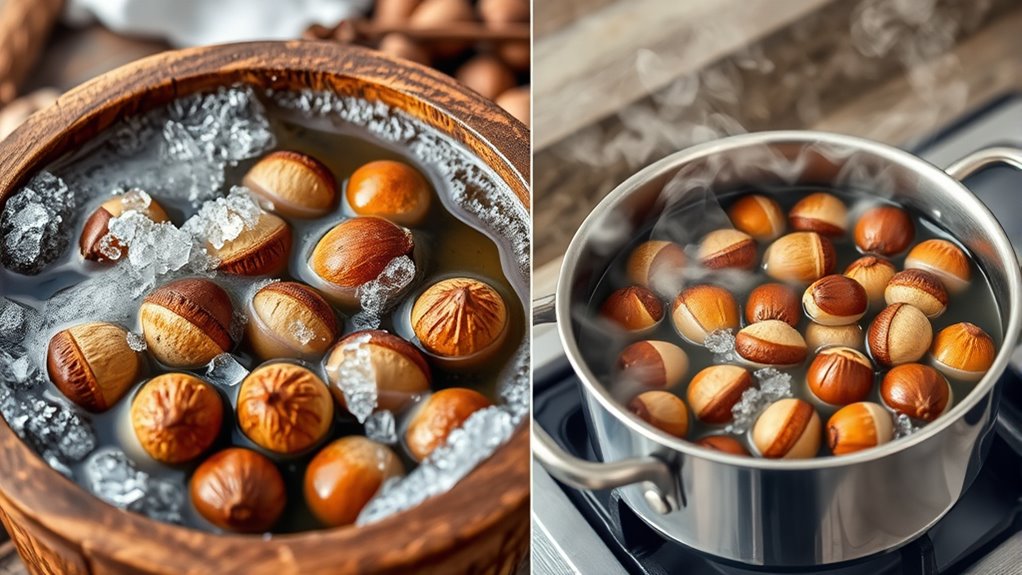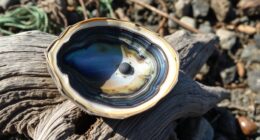When leaching acorns, cold methods involve soaking the nut meat in water at room temperature, changing the water daily over several days to gradually remove tannins. Hot methods, on the other hand, use boiling or simmering to quickly extract tannins, but may cause some nutrient loss. Cold leaching preserves more flavor and nutrients, while hot is faster. If you want to understand which method suits your needs best, keep exploring the details below.
Key Takeaways
- Cold leaching involves soaking nut meat in water at room temperature, changing water daily over several days.
- Hot leaching uses boiling or simmering to quickly remove tannins, typically within 15-30 minutes.
- Cold leaching preserves more nutrients and flavor but is slower; hot leaching speeds up tannin removal.
- Hot leaching may cause some nutrient loss and alters flavor, while cold leaching maintains more original taste.
- Both methods require patience and regular water changes to effectively remove tannins and ensure safety.

Have you ever wondered why acorns taste bitter or contain tannins? The answer lies in their natural chemical makeup, which includes tannic acid, a compound that can cause a dry, astringent sensation in your mouth. To enjoy acorns safely and deliciously, you need to understand nut preparation, especially how to leach out these tannins. Proper leaching transforms acorns from bitter, inedible nuts into a sweet, nutritious snack or ingredient. When foraging tips come into play, it’s essential to gather only mature acorns, which typically fall from oak trees during autumn. Avoid nuts that are shriveled or moldy, and always inspect your harvest for pests or damage to guarantee quality.
To enjoy sweet, nutritious acorns, properly leach out tannins from mature, healthy nuts after harvesting.
Once you’ve collected your acorns, the first step is to crack the shells open and remove the nut meat. This process can be time-consuming but is vital for effective leaching. There are two primary methods: cold and hot leaching. Cold leaching involves soaking the shelled acorns in water at room temperature, changing the water frequently over several days. This gradual process allows tannins to leach out slowly without destroying the nut’s natural flavor or texture. It’s a preferred method if you want to retain more nutrients and delicate flavors. On the other hand, hot leaching involves boiling or simmering the acorns in water, which speeds up tannin removal but can also cause some loss of flavor or nutrients if not carefully monitored. Some people prefer hot leaching for its efficiency, especially when preparing larger quantities.
When using cold leaching, you should change the water at least once or twice daily, and the process can take anywhere from three to five days. During this time, you’ll notice the water becoming darker as tannins dissolve out of the nuts. For hot leaching, bring a pot of water to a boil, add the nut meat, and let it simmer for about 15 to 30 minutes, then drain and rinse repeatedly until the water runs clear. Both methods require patience, but cold leaching is gentler and often produces a sweeter, less processed flavor. Proper leaching not only ensures safety but also preserves the nutritional integrity of the acorns, making them more beneficial in your diet.
Foraging tips are also essential to guarantee you’re harvesting safe, edible acorns. Avoid nuts from oak trees that appear diseased or infested. Always identify the species correctly, as some oaks produce acorns with higher tannin content, making them more bitter. After harvesting, dry the acorns thoroughly to prevent mold, and plan your nut preparation steps carefully to maximize flavor and nutritional value. Whether you choose cold or hot leaching, the key is consistent water changes and patience, ultimately giving you a tasty, tannin-free acorn that’s perfect for baking, grinding into flour, or snacking.
Frequently Asked Questions
How Long Should Acorns Be Soaked for Optimal Leaching?
You should soak acorns for about 12 to 24 hours for ideal timing. During this soaking duration, change the water regularly to help leach out tannins effectively. Keep an eye on the acorns, making sure they stay submerged, and don’t rush the process. This ensures the tannins are removed thoroughly, making the acorns safe and tasty for consumption. Proper soaking duration is key to successful leaching.
Can Leached Acorns Be Stored for Later Use?
Absolutely, you can store leached acorns for later use. To maintain their freshness, use airtight containers or resealable bags, and keep them in a cool, dark spot like a pantry or freezer. Proper acorn preservation ensures they’ll stay safe and snack-worthy for months. Follow effective storage techniques, and you’ll have ready-to-use acorns anytime, saving time and effort while savoring seasonal flavors.
Are There Specific Acorn Varieties Better Suited for Cold or Hot Leaching?
Some acorn varieties, like tan oak or red oak, have better acorn quality for cold or hot leaching. Red oaks tend to leach more efficiently with hot water, removing tannins quickly, while white oaks are better suited for cold leaching, preserving their flavor. Selecting the right variety enhances leaching efficiency and ensures you get the most nutritious and tasty acorns for your needs.
What Are Common Mistakes to Avoid During the Leaching Process?
Think of leaching as a delicate dance—you don’t want to trip over common mistakes. Avoid over soaking, which can cause the acorns to become mushy and lose nutrients. Also, don’t forget proper disposal of the leachate; dumping it improperly harms the environment. Keep an eye on timing, and don’t rush the process, or you’ll end up with bitter, unpalatable acorns instead of the tasty treats you seek.
How Do I Know When Acorns Are Fully Leached and Ready to Eat?
You’ll know acorns are fully leached when they no longer taste bitter and have a mild, nutty flavor, indicating nutrient retention and flavor enhancement. Check for a clean, smooth texture and verify no residual tannins cause bitterness. Replace the water regularly during leaching, and taste-test frequently. When they taste fresh and nutty, with no bitter aftertaste, they’re ready to eat and safe for consumption.
Conclusion
Whether you choose cold or hot leaching, remember that about 90% of tannins can be removed effectively. Cold leaching preserves more nutrients but takes longer, while hot leaching speeds up the process. Knowing these methods helps you prepare acorns safely and enjoy their nutty flavor. So next time, you’ll confidently decide which technique suits your schedule—just keep in mind that patience yields the best-tasting, tannin-free acorns for your recipes.










